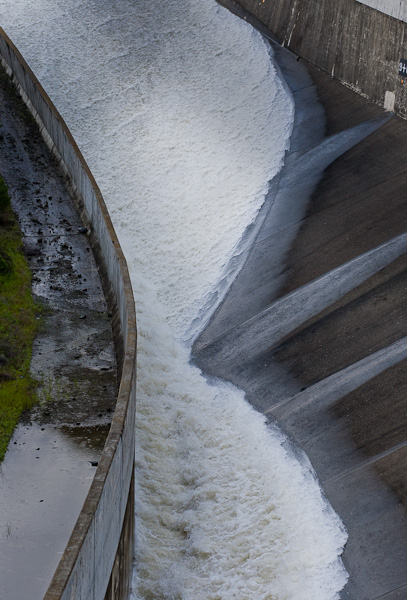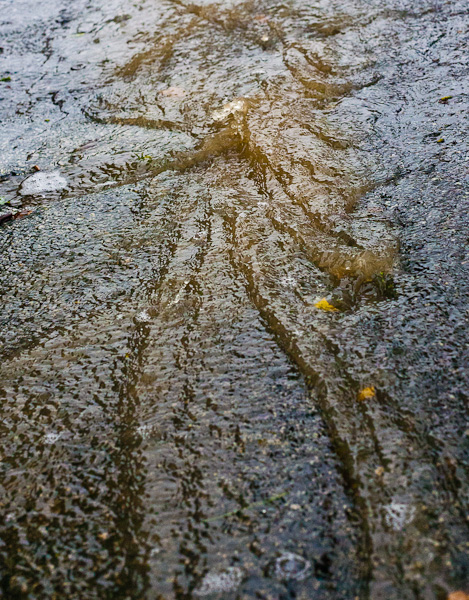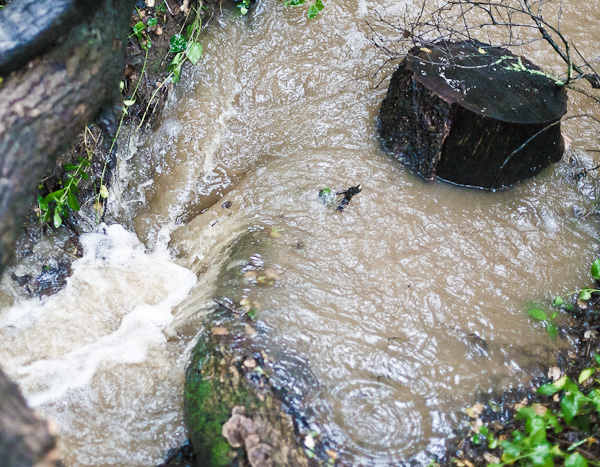I live near the Lexington Reservoir, which is next to Highway 17 near Los Gatos, CA. It’s very rare for the Lex to overflow—the last time I clearly remember it happening was nearly twenty years ago, late in 1992, shortly after Bill Clinton had won his first Presidential election.

Today the Lex finally overflowed again. I’d been tracking the progress via drive-bys and an online gauge page. Sylvia and I drove over just now to check it out in person.
When I see water in these dramatic states, I’m sometimes a little amazed at how calmly the water does its thing. No resistance. Go with the flow. Remain restless.

Further down the flume, of course, things get hyper. Yet even here, the bits of water are computing their way along continuous trajectories.

I often think about the theory of computation when looking at fluid flow, as in the photo above (taken in a gutter near my house during yesterday’s rainstorm). One reason fluids in motion are so fascinating is that make a huge amount of physical computation visible.
As the early chaoticians and the later computer scientists such as Stephen Wolfram and myself have pointed out (see for instance my Lifebox tome, readable online), computations fall into roughly three classes, which we might term the Dull, the Gnarly, and the Pseudorandom—you can see these three modes from the top to bottom in the photo above.
Before the waterfall it’s Dull, in the waterfall it’s Gnarly, in the crash zone at the bottom it’s Pseudorandom.
Sorting it through, in the Dull, low-end category, nothing much is happening—you’re getting phenomena like the smooth laminar flow of a non-turbulent stream.

In the wild, high-end Pseudorandom, messy zone, you get patterns that are very hard to decipher. Computer scientists say pseudorandom rather than random because, if physics were in fact to be fully deterministic (as it actually may be, despite the smoke and mirrors of quantum mechanics), then nothing is “random” in the sense of “utterly arbitrary.” Everything emerges from a prior cause—only it’s (even in principle) impossible for our smallish minds ever to trace the full webs of natural cause and effect.

Computationally speaking, the in-between Gnarly zone is where the action is, as in the photo above. Living organisms or minds aren’t Dull computations, nor are they Pseudorandom. They’re Gnarly. That is, on the one hand, they’re somewhat orderly, allowing one to adapt to them. And, on the other hand, they’re not fubar, that is, f*cked-up-beyond-all-recognition.

Am I a stump amid the flow? Well, no, I am flow. Dull, gnarly, and pseudorandom, depending on my mood…
By the way, if you could see the air currents, they’d be equally fascinating—now and then, when it’s misty or foggy, you can in fact begin to appreciate the dancing vortices of the air. I wish I had some special glasses that would let me see the air.

That’s about enough for today, but I’ll throw in two more watery photos. First a shot I got of a “Weedy Seadragon” at the Monterey Aquarium on my birthday earlier this week. Gnarly, dude.

And in closing, an awe-inspiring and slightly scary picture of the vast sea and sky off Moss Landing. Come on in. The water’s fine.









March 25th, 2011 at 12:54 pm
Watery gnarl. My yard is flooded, and the chickens are ankle deep in puddle.
March 25th, 2011 at 1:35 pm
party on, stump! F*BAR! har.
March 25th, 2011 at 7:58 pm
I wish my life would just remain comfortably gnarly instead of regularly edging into pseudorandomness, which feels very like utter chaos.
March 28th, 2011 at 10:27 am
Most people need a sunset or a canyon or a set of fractals to give them inspiration; you have the imagination to see universes in a flow of water. Thanx for lending us your eyes.
April 3rd, 2012 at 4:54 am
The pics are just a great way to communicate much than the wording. lovely to go through.